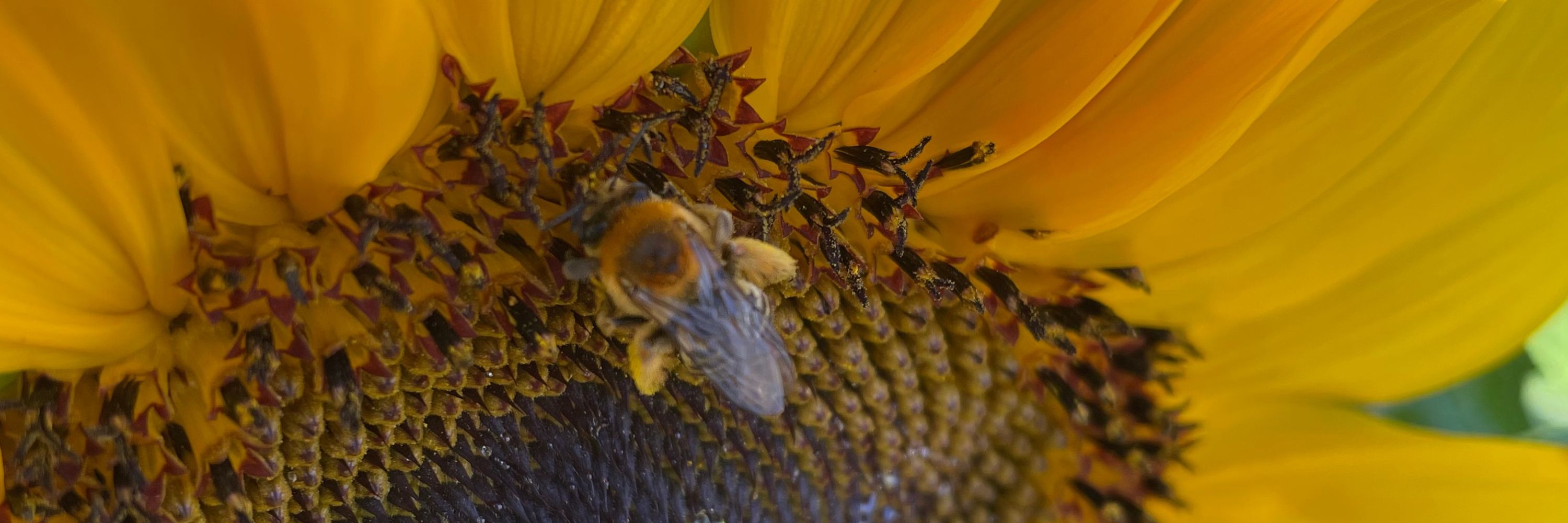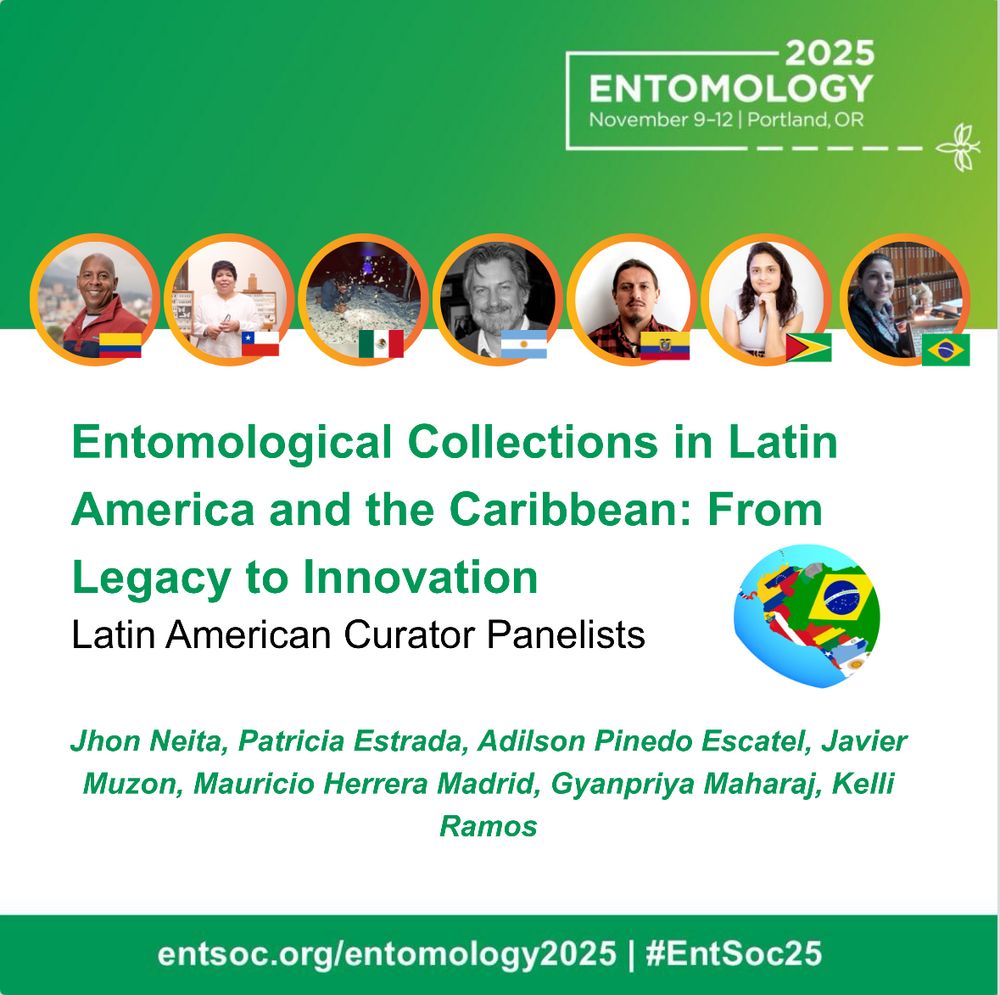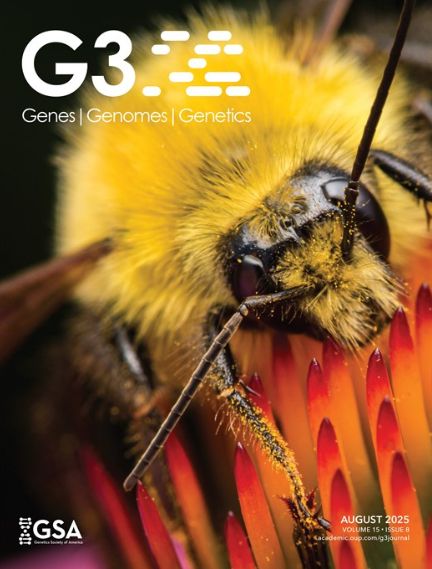
Margarita Lopez-Uribe
@mmlopezu.bsky.social
Tomorrow Tuesday at #EntSoc25 Portland Ballroom at 8am!
#EntSoc2025 #LatinAmericanEntomology #InsectCollections #Biodiversity
Tuesday Nov 11 at 8am in Portland Ballroom 256
Plenarists — Katja Seltmann, Juanita Rodriguez, Robert P. Guralnick, and John Abbott will explore how entomological collections connect the past and future of biodiversity research.
Tuesday Nov 11 at 8am in Portland Ballroom 256
Plenarists — Katja Seltmann, Juanita Rodriguez, Robert P. Guralnick, and John Abbott will explore how entomological collections connect the past and future of biodiversity research.

November 11, 2025 at 12:15 AM
Tomorrow Tuesday at #EntSoc25 Portland Ballroom at 8am!
Reposted by Margarita Lopez-Uribe
Enjoying Portland’s fall moss before #EntSoc2025! Join me Sunday (8–8:20 AM, Room B114) for my talk on how space and species shape stingless bee colony microbiomes — part of the symposium 'Inside and Out: Roles of Environmental and Gut Symbioses' with lots of great talks!

November 7, 2025 at 9:07 PM
Enjoying Portland’s fall moss before #EntSoc2025! Join me Sunday (8–8:20 AM, Room B114) for my talk on how space and species shape stingless bee colony microbiomes — part of the symposium 'Inside and Out: Roles of Environmental and Gut Symbioses' with lots of great talks!
Reposted by Margarita Lopez-Uribe
@mmlopezu.bsky.social and I bring “Entomological Collections in Latin America and the Caribbean” to #EntSoc25 — voices from the Americas on access, sustainability, and equity. #GlobalSouthScience
Check the Panelists! @entsocamerica.bsky.social @entcollnet.bsky.social
Check the Panelists! @entsocamerica.bsky.social @entcollnet.bsky.social
#EntSoc25
Tuesday Nov 11 at 8am in Portland Ballroom 256
Meet our Curator Panelists
Jhon Neita 🇨🇴, Patricia Estrada 🇨🇱, Adilson Pinedo Escatel 🇲🇽, Javier Muzon 🇦🇷,Mauricio Herrera Madrid 🇪🇨, Gyanpriya Maharaj 🇬🇾, Kelli Ramos 🇧🇷
Tuesday Nov 11 at 8am in Portland Ballroom 256
Meet our Curator Panelists
Jhon Neita 🇨🇴, Patricia Estrada 🇨🇱, Adilson Pinedo Escatel 🇲🇽, Javier Muzon 🇦🇷,Mauricio Herrera Madrid 🇪🇨, Gyanpriya Maharaj 🇬🇾, Kelli Ramos 🇧🇷

November 5, 2025 at 7:14 AM
@mmlopezu.bsky.social and I bring “Entomological Collections in Latin America and the Caribbean” to #EntSoc25 — voices from the Americas on access, sustainability, and equity. #GlobalSouthScience
Check the Panelists! @entsocamerica.bsky.social @entcollnet.bsky.social
Check the Panelists! @entsocamerica.bsky.social @entcollnet.bsky.social
Reposted by Margarita Lopez-Uribe
Innovation in insect collections starts here — meet our #EntSoc25 plenarists. #GlobalSouthScience @mmlopezu.bsky.social @entsocamerica.bsky.social
#EntSoc2025 #LatinAmericanEntomology #InsectCollections #Biodiversity
Tuesday Nov 11 at 8am in Portland Ballroom 256
Plenarists — Katja Seltmann, Juanita Rodriguez, Robert P. Guralnick, and John Abbott will explore how entomological collections connect the past and future of biodiversity research.
Tuesday Nov 11 at 8am in Portland Ballroom 256
Plenarists — Katja Seltmann, Juanita Rodriguez, Robert P. Guralnick, and John Abbott will explore how entomological collections connect the past and future of biodiversity research.

November 5, 2025 at 7:16 AM
Innovation in insect collections starts here — meet our #EntSoc25 plenarists. #GlobalSouthScience @mmlopezu.bsky.social @entsocamerica.bsky.social
Reposted by Margarita Lopez-Uribe
Entomology 2025 begins in five days! As you're exploring the program, what session are you most looking forward to? (Other than your own.😉) entomology2025.eventscribe.net Reply or quote to share. #EntSoc25

November 4, 2025 at 6:20 PM
Entomology 2025 begins in five days! As you're exploring the program, what session are you most looking forward to? (Other than your own.😉) entomology2025.eventscribe.net Reply or quote to share. #EntSoc25
#EntSoc25
Tuesday Nov 11 at 8am in Portland Ballroom 256
Meet our Curator Panelists
Jhon Neita 🇨🇴, Patricia Estrada 🇨🇱, Adilson Pinedo Escatel 🇲🇽, Javier Muzon 🇦🇷,Mauricio Herrera Madrid 🇪🇨, Gyanpriya Maharaj 🇬🇾, Kelli Ramos 🇧🇷
Tuesday Nov 11 at 8am in Portland Ballroom 256
Meet our Curator Panelists
Jhon Neita 🇨🇴, Patricia Estrada 🇨🇱, Adilson Pinedo Escatel 🇲🇽, Javier Muzon 🇦🇷,Mauricio Herrera Madrid 🇪🇨, Gyanpriya Maharaj 🇬🇾, Kelli Ramos 🇧🇷

November 4, 2025 at 10:42 PM
#EntSoc25
Tuesday Nov 11 at 8am in Portland Ballroom 256
Meet our Curator Panelists
Jhon Neita 🇨🇴, Patricia Estrada 🇨🇱, Adilson Pinedo Escatel 🇲🇽, Javier Muzon 🇦🇷,Mauricio Herrera Madrid 🇪🇨, Gyanpriya Maharaj 🇬🇾, Kelli Ramos 🇧🇷
Tuesday Nov 11 at 8am in Portland Ballroom 256
Meet our Curator Panelists
Jhon Neita 🇨🇴, Patricia Estrada 🇨🇱, Adilson Pinedo Escatel 🇲🇽, Javier Muzon 🇦🇷,Mauricio Herrera Madrid 🇪🇨, Gyanpriya Maharaj 🇬🇾, Kelli Ramos 🇧🇷
Reposted by Margarita Lopez-Uribe
#EntSoc25 Curious about the future of bee taxonomy? Join our workshop to explore its current state, identify research gaps, and discover innovative solutions shaping the field. Wednesday at 1:30 PM in C25 @entsocamerica.bsky.social 🐝🧬🔬 @isabellamanning.bsky.social @mmlopezu.bsky.social

November 4, 2025 at 7:01 PM
#EntSoc25 Curious about the future of bee taxonomy? Join our workshop to explore its current state, identify research gaps, and discover innovative solutions shaping the field. Wednesday at 1:30 PM in C25 @entsocamerica.bsky.social 🐝🧬🔬 @isabellamanning.bsky.social @mmlopezu.bsky.social
#EntSoc2025 #LatinAmericanEntomology #InsectCollections #Biodiversity
Tuesday Nov 11 at 8am in Portland Ballroom 256
Plenarists — Katja Seltmann, Juanita Rodriguez, Robert P. Guralnick, and John Abbott will explore how entomological collections connect the past and future of biodiversity research.
Tuesday Nov 11 at 8am in Portland Ballroom 256
Plenarists — Katja Seltmann, Juanita Rodriguez, Robert P. Guralnick, and John Abbott will explore how entomological collections connect the past and future of biodiversity research.

November 4, 2025 at 10:34 PM
#EntSoc2025 #LatinAmericanEntomology #InsectCollections #Biodiversity
Tuesday Nov 11 at 8am in Portland Ballroom 256
Plenarists — Katja Seltmann, Juanita Rodriguez, Robert P. Guralnick, and John Abbott will explore how entomological collections connect the past and future of biodiversity research.
Tuesday Nov 11 at 8am in Portland Ballroom 256
Plenarists — Katja Seltmann, Juanita Rodriguez, Robert P. Guralnick, and John Abbott will explore how entomological collections connect the past and future of biodiversity research.
Reposted by Margarita Lopez-Uribe
#EntSoc25 Join us for our symposium on Ecophysiology of Social Insects. Wednesday at 9:30 am in Portland Ballroom 251. @entsocamerica.bsky.social @jelenabujan.bsky.social @mmlopezu.bsky.social @isabellamanning.bsky.social


November 3, 2025 at 10:14 PM
#EntSoc25 Join us for our symposium on Ecophysiology of Social Insects. Wednesday at 9:30 am in Portland Ballroom 251. @entsocamerica.bsky.social @jelenabujan.bsky.social @mmlopezu.bsky.social @isabellamanning.bsky.social
Reposted by Margarita Lopez-Uribe
An article about a former lab tech in my lab, Kim Ballare, in the new NYTimes "Lost Science" series about impacts of federal cuts. Thanks to @carlzimmer.com for doing this!
www.nytimes.com/2025/10/08/s...
www.nytimes.com/2025/10/08/s...

She Studied How Logging Affects Pollinators
www.nytimes.com
October 13, 2025 at 8:00 PM
An article about a former lab tech in my lab, Kim Ballare, in the new NYTimes "Lost Science" series about impacts of federal cuts. Thanks to @carlzimmer.com for doing this!
www.nytimes.com/2025/10/08/s...
www.nytimes.com/2025/10/08/s...
Reposted by Margarita Lopez-Uribe
Apply to become the next MSU EEB Presidential Postdoctoral Fellow!
These are two year positions with research stipend, working with 2+ MSU EEB faculty. Applications due 10 November 2025. More here:
eeb.msu.edu/initiatives/...
These are two year positions with research stipend, working with 2+ MSU EEB faculty. Applications due 10 November 2025. More here:
eeb.msu.edu/initiatives/...

Postdoctoral Fellowship - Ecology, Evolution, and Behavior
eeb.msu.edu
October 7, 2025 at 2:51 PM
Apply to become the next MSU EEB Presidential Postdoctoral Fellow!
These are two year positions with research stipend, working with 2+ MSU EEB faculty. Applications due 10 November 2025. More here:
eeb.msu.edu/initiatives/...
These are two year positions with research stipend, working with 2+ MSU EEB faculty. Applications due 10 November 2025. More here:
eeb.msu.edu/initiatives/...
🌼 New paper showing that it's not just pollinators shaping flowers—abiotic factors like humidity and temperature also influence floral form and function. Check out this new paper on a more complex picture of floral evolution. 🌬️🐝
www.sciencedirect.com/science/arti...
www.sciencedirect.com/science/arti...

October 7, 2025 at 3:28 PM
🌼 New paper showing that it's not just pollinators shaping flowers—abiotic factors like humidity and temperature also influence floral form and function. Check out this new paper on a more complex picture of floral evolution. 🌬️🐝
www.sciencedirect.com/science/arti...
www.sciencedirect.com/science/arti...
Sad about this news. What a great legacy she leaves behind.
BREAKING: Jane Goodall, the conservationist renowned for chimpanzee research and environmental advocacy, has died.

Jane Goodall, conservationist renowned for chimpanzee research and environmental advocacy, has died
Jane Goodall, the conservationist renowned for her groundbreaking chimpanzee field research and globe-spanning environmental advocacy, has died. She was 91.
bit.ly
October 1, 2025 at 7:26 PM
Sad about this news. What a great legacy she leaves behind.
Reposted by Margarita Lopez-Uribe
NSF’s doors will be closed at 1:30 pm today. While you may be able to submit things, there will be no staff to process anything. In fact it is illegal for us to even open our work computers or email during a shutdown. A very few rotators may be able to communicate, so check out of office responses.
Navigating A Government Shutdown: One-Stop Resource Page
As of 12:01 AM on October 1, Donald Trump and Republicans in Congress have shut down the government.
raskin.house.gov
October 1, 2025 at 5:56 AM
NSF’s doors will be closed at 1:30 pm today. While you may be able to submit things, there will be no staff to process anything. In fact it is illegal for us to even open our work computers or email during a shutdown. A very few rotators may be able to communicate, so check out of office responses.
Reposted by Margarita Lopez-Uribe
A new study finds that developmental stress is associated with young workers leaving hives too early and dying outside. Management tools like extra feeding + brood breaks can rescue stressed colonies
#HoneyBees #Pollinators #ColonyHealth
@julirangel.bsky.social
link.springer.com/article/10.1...
#HoneyBees #Pollinators #ColonyHealth
@julirangel.bsky.social
link.springer.com/article/10.1...

Modeling the effects of stress and premature hive exiting behavior on honey bee (Apis mellifera) colony survival - Apidologie
Honey bees have a complex social structure, with many factors affecting colony survival. Mathematical models are therefore valuable for understanding how individual variables affect honey bee colony dynamics. Previous honey bee population models have shown that accelerated aging due to stress can lead to colony decline. Our previous work showed that general developmental stress causes a previously undocumented behavior whereby very young workers exit the colony before they can fly, leading them to die prematurely on the ground outside the hive. In this study, we modeled the effects of this premature hive exiting behavior on colony survival. We used parameters from previous studies to inform our model and incorporated empirical data regarding the rate of premature hive exiting behavior driven by various developmental stressors. An equation to link premature exit with accelerated aging was also introduced to mirror population dynamics across different worker age groups. We found that higher rates of premature hive exiting behavior can accelerate colony collapse. A feeding variable (provisioning colonies with extra sugar syrup) and a brood break variable (preventing the queen from laying eggs for a given time period to decrease Varroa mite levels) were added to the model to examine ways to counteract the negative effects of premature hive exiting behavior and to assess their effectiveness at regulating the progression of worker aging. Our results suggest that both supplemental feeding and implementing brood breaks can bring a colony back from the brink of collapse.
link.springer.com
September 30, 2025 at 12:39 PM
A new study finds that developmental stress is associated with young workers leaving hives too early and dying outside. Management tools like extra feeding + brood breaks can rescue stressed colonies
#HoneyBees #Pollinators #ColonyHealth
@julirangel.bsky.social
link.springer.com/article/10.1...
#HoneyBees #Pollinators #ColonyHealth
@julirangel.bsky.social
link.springer.com/article/10.1...
Reposted by Margarita Lopez-Uribe
🐝 New review: Past, present, and future of SSR molecular markers in bee studies. The study is based on 576 papers from 173 species. Results find that most work has focused on Apis & Bombus 🐝 and that SSRs remain powerful + low-cost for bee research
#Bees #Genetics
link.springer.com/article/10.1...
#Bees #Genetics
link.springer.com/article/10.1...

Past, present, and future of SSR molecular markers in bee studies - Apidologie
Understanding bees, with their extensive morphological, phylogenetic, and behavioral diversity and their significant economic and ecological roles, requires integrating classical and modern scientific methods. Microsatellite (SSR—Simple Sequence Repeat) markers are a low-cost tool useful for various investigations at individual, colony, population, and species levels. However, a comprehensive review on the applications, trends, and Limitations of molecular markers in bee studies is lacking. We aimed to systematize the knowledge about microsatellite markers in bee research, characterize research trends, discuss their applications, and present their advantages and Limitations to address major knowledge gaps across various research themes. Additionally, we aimed to establish a preliminary database of microsatellite primers and their transferability across related species. We conducted a systematic review of research articles on microsatellites and bees published until 2023. Our review included 576 articles from all biogeographical realms, which covered 173 species from 19 families. Apidae (94.1%) and Halictidae (3.4%) were the most frequent bee families in studies, with a strong dominance of Apis and Bombus species, followed by Meliponini species. Future research should include more solitary species and additional species from underrepresented tribes. The reviewed articles spanned 11 research themes, ranging from basic bee biology to applied and multi-disciplinary research, with reproduction, conservation, behavior, evolution, breeding, and beekeeping being the most frequent themes. Microsatellite markers are a suitable choice for most research themes and show a promising trend for continued use in future bee studies.
link.springer.com
September 30, 2025 at 12:33 PM
🐝 New review: Past, present, and future of SSR molecular markers in bee studies. The study is based on 576 papers from 173 species. Results find that most work has focused on Apis & Bombus 🐝 and that SSRs remain powerful + low-cost for bee research
#Bees #Genetics
link.springer.com/article/10.1...
#Bees #Genetics
link.springer.com/article/10.1...
Reposted by Margarita Lopez-Uribe
Consider signing - Petition to NSF to Restore Eligibility for the 2026 Graduate Research Fellowship Program Competition 🧪🌐https://laurenkuehne.github.io/grfpChanges/
Petition to NSF to Restore Eligibility for the 2026 Graduate Research Fellowship Program Competition
laurenkuehne.github.io
September 30, 2025 at 12:06 PM
Consider signing - Petition to NSF to Restore Eligibility for the 2026 Graduate Research Fellowship Program Competition 🧪🌐https://laurenkuehne.github.io/grfpChanges/
New study on the genetic diversity and population structure of the decline oak savanna plant Lupinus perennis
academic.oup.com/aobpla/artic...
academic.oup.com/aobpla/artic...

Assessing the status of sundial lupine (Lupinus perennis L.) genetic diversity and population structure throughout its distribution
Habitat loss threatens plant genetic diversity, with consequences for species survival and ecosystem health. This study describes the genetic diversity, st
academic.oup.com
September 23, 2025 at 2:12 PM
New study on the genetic diversity and population structure of the decline oak savanna plant Lupinus perennis
academic.oup.com/aobpla/artic...
academic.oup.com/aobpla/artic...
Reposted by Margarita Lopez-Uribe
New study in #G3journal from @mmlopezu.bsky.social and the team reveals the importance of diet in #Bee sensory gene evolution, where generalists lose odorant receptors and gain gustatory receptors, while specialists diversify existing genes. buff.ly/1LSfQpl

September 5, 2025 at 6:01 PM
New study in #G3journal from @mmlopezu.bsky.social and the team reveals the importance of diet in #Bee sensory gene evolution, where generalists lose odorant receptors and gain gustatory receptors, while specialists diversify existing genes. buff.ly/1LSfQpl
Reposted by Margarita Lopez-Uribe
1) Are you an Assistant Professor studying evolutionary biology?
2) Are you in the US?
3) Would you like to give a research seminar in Iowa?
4) Are you available to travel September 4-6?
If you can answer YES x4, please DM me ASAP, or comment below.
2) Are you in the US?
3) Would you like to give a research seminar in Iowa?
4) Are you available to travel September 4-6?
If you can answer YES x4, please DM me ASAP, or comment below.
August 14, 2025 at 8:09 PM
1) Are you an Assistant Professor studying evolutionary biology?
2) Are you in the US?
3) Would you like to give a research seminar in Iowa?
4) Are you available to travel September 4-6?
If you can answer YES x4, please DM me ASAP, or comment below.
2) Are you in the US?
3) Would you like to give a research seminar in Iowa?
4) Are you available to travel September 4-6?
If you can answer YES x4, please DM me ASAP, or comment below.
Reposted by Margarita Lopez-Uribe
My team has updated our free database of POSTDOC fellowships.
This database contains 286 entries. For each entry, we provide a link, short description, deadline, amount, and eligibility criteria.
Download this updated and expanded database here: research.jhu.edu/rdt/funding-...
This database contains 286 entries. For each entry, we provide a link, short description, deadline, amount, and eligibility criteria.
Download this updated and expanded database here: research.jhu.edu/rdt/funding-...

August 10, 2025 at 7:50 PM
My team has updated our free database of POSTDOC fellowships.
This database contains 286 entries. For each entry, we provide a link, short description, deadline, amount, and eligibility criteria.
Download this updated and expanded database here: research.jhu.edu/rdt/funding-...
This database contains 286 entries. For each entry, we provide a link, short description, deadline, amount, and eligibility criteria.
Download this updated and expanded database here: research.jhu.edu/rdt/funding-...
Cover image in #G3 highlighting our new paper in "Shifts in bee diet breadths are associated with gene gains and losses and positive selection across olfactory receptors"
academic.oup.com/g3journal/ar...
@genetics-gsa.bsky.social
academic.oup.com/g3journal/ar...
@genetics-gsa.bsky.social

August 7, 2025 at 1:20 PM
Cover image in #G3 highlighting our new paper in "Shifts in bee diet breadths are associated with gene gains and losses and positive selection across olfactory receptors"
academic.oup.com/g3journal/ar...
@genetics-gsa.bsky.social
academic.oup.com/g3journal/ar...
@genetics-gsa.bsky.social
Reposted by Margarita Lopez-Uribe
Science funding is still being finalized as Congress is now passing specific appropriations. The easiest way I have found to write to our reps is thru this simple form (you just need your ZIP code and a few sentences of things that matter to you, like science funding!)
www.aps.org/initiatives/...
www.aps.org/initiatives/...

Write Your Own Letter to Congress
The American Physical Society is a nonprofit membership organization working to advance physics by fostering a vibrant, inclusive, and global community dedicated to science and society.
www.aps.org
July 12, 2025 at 11:02 AM
Science funding is still being finalized as Congress is now passing specific appropriations. The easiest way I have found to write to our reps is thru this simple form (you just need your ZIP code and a few sentences of things that matter to you, like science funding!)
www.aps.org/initiatives/...
www.aps.org/initiatives/...


